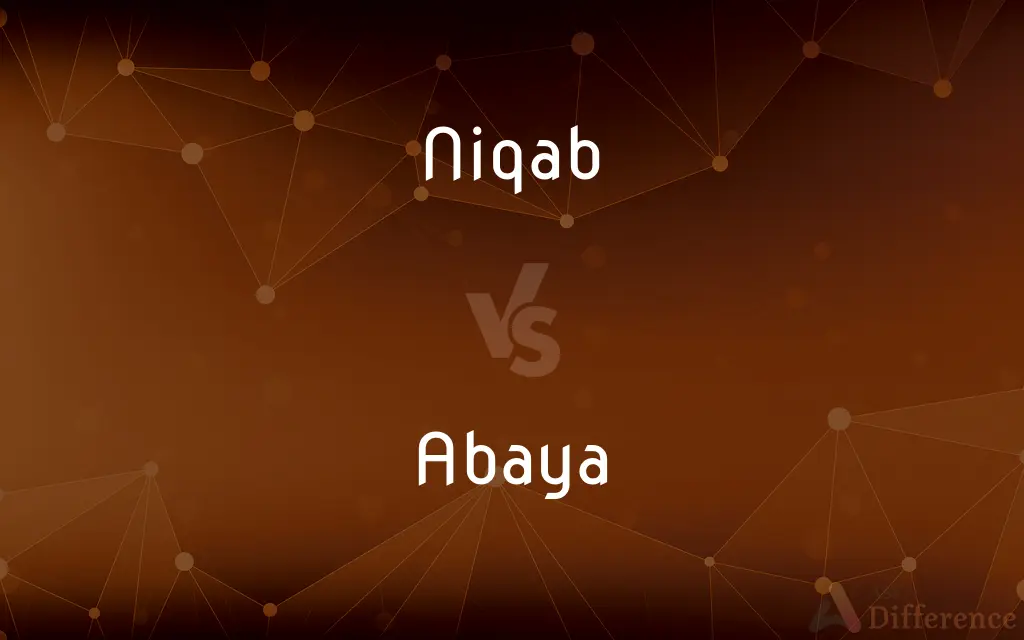Niqab vs. Abaya — What's the Difference?
By Tayyaba Rehman — Updated on September 28, 2023
Niqab is a veil covering the face, leaving the eyes clear, worn by some Muslim women; Abaya is a full-length, loose-fitting robe, often black, worn by some Muslim women as a cloak.

Difference Between Niqab and Abaya
Table of Contents
ADVERTISEMENT
Key Differences
Niqab and Abaya are both traditional Islamic attire items worn by women, but they serve different purposes and cover different parts of the body. The Niqab is primarily a veil designed to cover the face, usually leaving the area around the eyes clear. It serves to maintain modesty and privacy, allowing women to conceal their facial features from the public view. In contrast, the Abaya is a full-length, loose-fitting robe, often black in color, worn to cover the body from the shoulders to the ankles, symbolizing modesty and morality, and is usually paired with a headscarf.
While the Niqab is a facial veil focusing on maintaining the confidentiality of facial features, the Abaya is a comprehensive outer garment, aiming to modestly cover the body. The Niqab is usually worn with other traditional garments, and it predominantly emphasizes the value of privacy and modesty in facial exposure. On the other hand, the Abaya is more about modest dressing, providing a way for women to cover their regular clothes when they are out in public, emphasizing decency and propriety in overall appearance.
In terms of cultural and regional variations, the Niqab and the Abaya have different levels of prevalence and acceptance. The Niqab is more prevalent in some Arabian Peninsula countries, while it might be less common or even legally restricted in other regions due to security concerns. The Abaya, meanwhile, is widely worn across many Islamic countries, with variations in design, color, and style, reflecting the diverse cultural interpretations and adaptations of Islamic dress codes.
The adoption of the Niqab and the Abaya often depends on individual choice, familial or societal expectations, or legal mandates, reflecting the varying interpretations of modesty and morality in Islamic traditions. The Niqab, due to its specific purpose of covering the face, is often subject to more debate and contention, associated with identity and societal norms. The Abaya, as a more universally recognized symbol of modest dressing in Islamic cultures, continues to evolve in style and presentation, blending tradition with modernity, and accommodating the diverse aesthetic and practical needs of Muslim women.
Comparison Chart
Purpose
To cover the face, maintaining privacy and modesty.
To modestly cover the body from shoulders to ankles.
ADVERTISEMENT
Part of Body Covered
Face, usually leaving the eyes clear.
The whole body.
Associated Values
Privacy and modesty in facial exposure.
Decency and propriety in overall appearance.
Prevalence
More prevalent in some Arabian Peninsula countries.
Widely worn across many Islamic countries.
Variations
Typically a facial veil.
Variations in design, color, and style.
Compare with Definitions
Niqab
A facial veil worn by some Muslim women to maintain privacy and modesty by covering the face, usually leaving the eyes clear.
Sara wore a niqab as a sign of her devotion to her faith and its values.
Abaya
A full-length, loose-fitting robe worn by some Muslim women as a cloak to cover the body from shoulders to ankles.
Fatima wore a beautifully embroidered abaya when she went out.
Niqab
An Islamic attire piece focusing on concealing facial features except for the eyes.
The niqab is adopted by many women in some regions as part of their Islamic dress code.
Abaya
An outer garment symbolizing modesty and morality, often worn with a headscarf.
The abaya is a traditional garment reflecting decency and propriety in dressing.
Niqab
A veil associated with certain Islamic practices and societal norms, worn in addition to other traditional attire.
Wearing the niqab is a practice adhered to by women in specific cultures and regions.
Abaya
A piece of Islamic attire with variations in design, color, and style, reflecting diverse cultural interpretations of Islamic dress codes.
Modern abayas come in various styles and colors, blending tradition with contemporary fashion.
Niqab
A garment signifying values of modesty and privacy in facial exposure for women in some Islamic traditions.
The niqab, symbolizing modesty and privacy, is a chosen garment for many women in various Islamic societies.
Abaya
A universally recognized symbol of modest dressing in Islamic cultures, often paired with a headscarf.
The abaya, worn with a coordinating headscarf, is a representation of modest Islamic attire.
Niqab
A piece of cloth serving to maintain the confidentiality of the facial features of the wearer.
She chose to wear a niqab to adhere to her personal beliefs and values of modesty.
Abaya
A typically black robe, worn over regular clothes, adopted widely across many Islamic countries.
The black abaya, symbolizing modest dressing, is a common sight in many Islamic regions.
Niqab
A veil worn by Muslim women that covers most or all of the face, having a narrow opening or mesh covering for the eyes.
Abaya
The abaya "cloak" (colloquially and more commonly, Arabic: عباية ʿabāyah, especially in Literary Arabic: عباءة ʿabā'ah; plural عبايات ʿabāyāt, عباءات ʿabā'āt), sometimes also called an aba, is a simple, loose over-garment, essentially a robe-like dress, worn by some women in parts of the Muslim world including North Africa and Middle East and the Arabian Peninsula. Traditional abayat are black and may be either a large square of fabric draped from the shoulders or head or a long kaftan.
Niqab
A veil which covers the face, worn by some Muslim women as a part of sartorial hijab.
Abaya
A loose robe worn by Muslim women, especially in Arabic-speaking regions, covering the body from head to toe or the neck down and often worn with a headscarf and veil. Also called aba.
Niqab
A face veil covering the lower part of the face (up to the eyes) worn by observant Muslim women
Abaya
Synonym of aba
Abaya
(Arabic) a loose black robe from head to toe; traditionally worn by Muslim women
Common Curiosities
Do the Niqab and Abaya serve the same purpose in Islamic attire?
No, the Niqab covers the face, maintaining privacy, while the Abaya is a full-body cloak emphasizing overall modesty.
Is the Niqab worn to cover the entire face?
Yes, the Niqab is worn to cover the face, usually leaving the area around the eyes clear.
Is the Abaya a full-length robe?
Yes, the Abaya is a full-length, often loose-fitting, robe worn by some Muslim women.
Share Your Discovery

Previous Comparison
Chest vs. Trunk
Next Comparison
Maven vs. RavenAuthor Spotlight
Written by
Tayyaba RehmanTayyaba Rehman is a distinguished writer, currently serving as a primary contributor to askdifference.com. As a researcher in semantics and etymology, Tayyaba's passion for the complexity of languages and their distinctions has found a perfect home on the platform. Tayyaba delves into the intricacies of language, distinguishing between commonly confused words and phrases, thereby providing clarity for readers worldwide.
















































